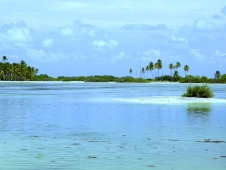Baker, J. D., Littnan, C. L. and Johnston, D. W. (2006) Potential effects of sea level rise on the terrestrial habitats of endangered and endemic megafauna in the Northwestern Hawaiian Islands. Endang. Spec. Res. 4: 1–10.
BirdLife International (2008) Threatened birds of the world 2008. CD-ROM. Cambridge, UK: BirdLife International.
Bennett, S., Kazemi, S., Kelly, S., Mardack, P., Nelson, N. and Hosking, J. (2007) The possible effects of projected sea-level rise. Pp. 17 in P. Olsen, ed. The state of Australia's birds 2007: birds in a changing climate. Wingspan 14 (Suppl.).
Church, J. A. and White, N. J. (2006) A 20th Century acceleration in global sea-level rise. Geophys. Res. Lett. 33: 1–4.
Galbraith, H., Jones, R., Park, R., Clough, J., Herrod-Julius, S., Harrington, B. and Page, G. (2002) Global climate change and sea level rise: potential losses of intertidal habitat for shorebirds. Waterbirds 25: 173–183.
Hughes, R. G. (2004) Climate change and loss of saltmarshes: consequences for birds. Ibis 146 (Suppl.1): 21–28.
IPCC (2007) Climate Change 2007: the physical science basis, summary for policymakers.Geneva, Switzerland: Intergovernmental Panel on Climactic Change (Fourth Assessment Report).
Le V. dit Durell, S. E. A., Stillman, R. A., Caldow, R. W. G., McGrorty, S., West, A. D. and Humphreys, J. (2006) Modelling the effect of environmental change on shorebirds: a case study on Poole Harbour, UK. Biol. Conserv. 131: 459–473.
McGranahan, D. A., Balk, D. and Anderson, B. (2007) The rising tide: assessing the risks of climate change and human settlements in low elevation coastal zones. Environ. Urban. 19: 17–39.
Overpeck, J. T., Otto-Bliesner, B. L., Miller, G. H., Muhs, D. R., Alley, R. B. and Kiehl, J. T. (2006) Paleoclimatic evidence for future ice-sheet instability and rapid sea-level rise. Science 311: 1747–1750.
Rahmstorf, S., Cazenave, A., Church, J. A., Hansen, J. E., Keeling, R. F., Parker, D. E. and Somerville, R. C. J. (2007) Recent climate observations compared to projections. Science 316: 709.
Reynolds, M. H., Courtot, K. N., Berkowitz, P., Storlazzi, C. D., Moore, J. and Flint, E. (2015) Will the Effects of Sea-Level Rise Create Ecological Traps for Pacific Island Seabirds? PLoS ONE 10: e0136773
Rignot, E. and Kanagaratnam, P. (2006) Changes in the velocity structure of the Greenland ice sheet. Science 311: 986–990.

